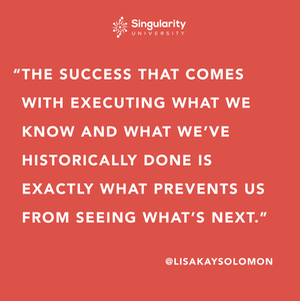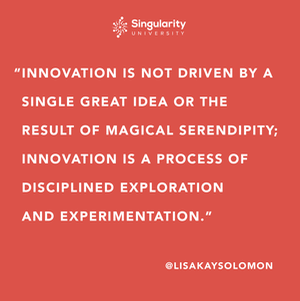This article is part of a new series exploring the skills leaders must learn to make the most of rapid change in an increasingly disruptive world. The first article in the series, “How the Most Successful Leaders Will Thrive in an Exponential World,” broadly outlines four critical leadership skills—futurist, technologist, innovator, and humanitarian—and how they work together.
Today’s post, part four in the series, takes a more detailed look at leaders as innovators. Be sure to check out part two of the series, “How Leaders Dream Boldly to Bring New Futures to Life,” part three of the series, “How All Leaders Can Make the World a Better Place,” and stay tuned for an upcoming article exploring leaders as technologists.
Jeff Bezos is arguably one of today’s most innovative leaders. He is a great example of a leader who imagines possible new futures and has created an organization that puts as much discipline into innovating as it does into bringing those new ideas to life.
In the 20-plus years Amazon has been in business, Bezos has entered and disrupted multiple industries — retail and technology infrastructure, for example — pioneering new business models that make competition irrelevant.
How does Amazon do it?
In a recently released shareholder letter Bezos outlined Amazon’s operating principles which he calls “Day 1.” To Bezos, Day 1 represents being a customer-obsessed company that focuses on experimentation, utilizing external trends, being skeptical of information, and making quick decisions. Bezos is obsessed with creating an innovative company and culture: “Day 2 is stasis. Followed by irrelevance. Followed by excruciating, painful decline. Followed by death. And that is why it is always Day 1.”
Being innovative like Amazon isn’t just valuable in tech — it’s a key skill for all leaders. We live in a fast-paced world, where even the biggest companies can be disrupted.
But making a company innovative from the roots up is no easy task. To lead like an innovator means investing in the right mindset, culture, incentives and support throughout your organization. It means looking beyond a single brilliant idea and instead creating an iterative system focused on value creation and scalable growth.
Innovation Starts With the Right Mindset
Successful innovators know that bringing something new to life — something of value that creates positive impact for customers, partners or communities — requires a mindset focused on discovery of the unknown, not on execution of the existing.
 This may sound simple, but embracing a discovery mindset is almost antithetical to how we’ve been taught and trained. Nearly all our formal education focuses on performance rewarding “right” answers and defendable arguments. Our organizations tend to promote individuals who ace their performance reviews, rewarding execution and risk management over divergent thinking and questioning.
This may sound simple, but embracing a discovery mindset is almost antithetical to how we’ve been taught and trained. Nearly all our formal education focuses on performance rewarding “right” answers and defendable arguments. Our organizations tend to promote individuals who ace their performance reviews, rewarding execution and risk management over divergent thinking and questioning.
And yet, the success that comes with executing what we know and what we’ve historically done is exactly what prevents us from seeing what’s next.
Microsoft’s CEO Satya Nadella believes instilling a culture of discovery is critical to the company’s future success. After taking the reins at Microsoft, he endorsed the importance of a “growth mindset,” emphasizing learning from others and from our own mistakes to move quickly and find the right path forward. Nadella says, “We want to push to be more of a learn-it-all culture than a know-it-all culture.”
At the heart of a discovery mindset is the willingness to ask different questions. In his research for his latest book, A More Beautiful Question, author Warren Berger studied hundreds of innovative companies and found the original idea often came from asking divergent questions that “are ambitious and yet actionable, capable of shifting the way we think about something and to serve as a catalyst for change.”
The startup Calorie Cloud is a great example of a discovery mindset in practice.
Founders Troy Hickerson and Dan Byler got inspiration for the company after learning about a community church that collectively lost 200,000 pounds through group incentives. Half joking, they said that the community should have donated those calories to kids suffering from acute malnutrition. Then one founder asked, “Can we do that?”
To date, Calorie Cloud has helped exchange over 3.5 billion unwanted calories for much needed ones, inventing the first global market for calories.
So, mindset is important. But you don’t magically shift a whole organization’s mindset overnight. Thinking like an innovator has to become part of the culture.
Innovation Requires Investing in Culture
In his book The Geography of Genius, Eric Weiner explores why some cities were more creative and productive in certain moments of history than others.
After deep investigations of cities like ancient Athens during its Golden Age, Florence during the Renaissance, and present day Silicon Valley, Weiner finds their success comes back to a simple philosophical principle first coined by the great philosopher Plato: “What is honored in a country will be cultivated there.”
 In other words, what each city valued is what received investment, attention, talent and rewards, and by honoring and valuing the right things, we can achieve greatness.
In other words, what each city valued is what received investment, attention, talent and rewards, and by honoring and valuing the right things, we can achieve greatness.
At Pixar, one of the world’s most creative and innovative companies, the culture honors creative and technical talent working together to tell great stories. They highly value peer support and honest feedback across all levels of the company.
Catmull says Pixar is special because its workers have each other’s backs. They all want to do great work, but instead of going solo, they embrace an “all for one, one for all” mentality, productively criticizing each other’s ideas to make them better.
“Management’s job is not to prevent risk but to build the capability to recover when failures occur,” Catmull writes in his business classic Creativity, Inc. “It must be safe to tell the truth. We must constantly challenge all of our assumptions and search for the flaws that could destroy our culture.”
As Catmull notes, a culture of innovation starts at the top. Leaders have to embrace it first and then work tirelessly to protect, nurture, and reward innovative behavior.
Once innovation is baked into your culture, you can get down to work. But you still won’t get wildly creative and useful ideas without setting a few ground rules.
Innovation Is a Teachable and Learnable Discipline
Innovation is not driven by a single great idea or the result of magical serendipity; innovation is a process of disciplined exploration and experimentation.
There are many “playbooks” for innovation — lean, agile, and design-thinking, among others. Regardless of which you use, practicing innovation requires we learn seven essential skills that aren’t often taught in traditional education or training.
It All Starts With the Customer: Learn how to observe and see things objectively from a customer’s perspective. This allows us to identify what they really need not what we believe our current capabilities and features do for them.
Don’t Fly Solo: Learn how to engage and collaborate with colleagues and partners who bring diverse experience and perspectives to the effort. This might be nurtured by creating a war room, an unstructured space to allow new ideas to grow.
Tell Stories. Think and Work Visually: Practice presenting ideas in a compelling way — through story, metaphor and visualization — to help overcome our need for endless research data to ensure our ideas are the right ones.
Keep It Simple: Practice finding the simple idea hidden in the complexity. This is an ability to step back and see the big picture as well as break the big picture down to find the most critical thing that will lead to success now.
Set up Small Experiments: When we experiment, we learn if the value we’ve identified and how we deliver it are truly valued by our customers.
Embrace Uncertainty: When we expect change and cultivate a mindset of continuous learning and growth, we become an architect of hope for others.
Working at innovation gives us a chance to practice and learn these skills in rapid cycles. This has a flywheel effect — not only are ideas advanced in appropriate and measured ways, but also capability is catalyzed and scaled within the organization.
We Are All Capable of Being Innovators
Innovation takes more than lip service. It takes more than a brainstorming session where we generate a lot of ideas but few lead to meaningful change. Many of us have lots of ideas, but ideas alone do not necessarily result in successful innovation.
True innovation requires deep persistence and fierce resolve, a willingness to move forward when you’re not quite sure you will be successful, rapid adaptive cycles of learning, and the ability to connect and galvanize networks of diverse and committed talent to work together towards a larger goal.
In a recent interview, Apple CEO Tim Cook talked about the value of diversity in their organization. “Our best work comes from the diversity of ideas and people. We believe in a modern definition of diversity — the big D — which supports creative friction and its contribution to making better products.”
When you take the role of spokesperson or evangelist for innovation in your organization, you have the opportunity to bring about the improvement you want to see in the world and to inspire your colleagues to build the skills to do the same. In doing so, you can ignite and scale positive impact and architect a better future for all of us.
Image Credit: Bubble_Tea Stock / Shutterstock.com



